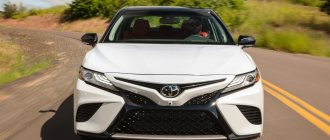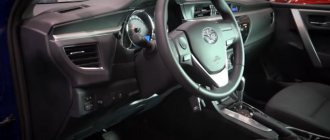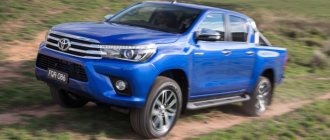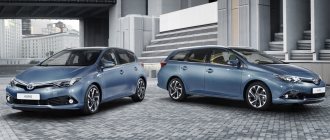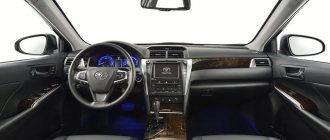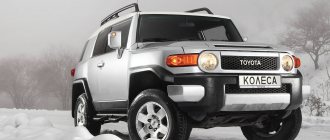For many, it would probably be interesting to get acquainted with the comparison test of such cars as the Toyota Camry and Honda Accord, arranging a speed competition between them on the auto track. But, unfortunately, we want to disappoint you a little in advance, this review and comparison is not of sports charged cars, as you would like, but a comparison of two cars designed only for a calm and measured ride, which are produced by Japanese companies for the masses of people.
The Camry and Accord are midsize full-size sedans. They are produced for car enthusiasts for whom the high speed of the car and its acceleration dynamics are not very important. These cars are designed for those who want (need) a car that is easy and simple to drive, with a spacious interior at the same time, as well as predictability, efficiency and reliability.
Cars of the Japanese brands Camry and Accord are very popular not only here in Russia, but throughout the world. Sales of these sedans are growing every year around the world. And this despite the fact that competition in this segment of cars is very strong. With such competition in the automobile market, the growth in sales of these car-sedan models speaks volumes; people (motorists) appreciated these two models of Japanese automakers.
Features that differentiate the new 2013 Accord and 2013 Camry from previous cars.
Toyota Camry did not receive any updates for itself in 2013, since it updated its lineup at the beginning of 2012. The car is completely identical to last year's model range. Much to our chagrin, according to many car enthusiasts, the new style of the Camry car is very controversial. Most likely, the model of this car will not be as successful in sales as its previous generation. But nevertheless, there are elements in the style of the new Camry model that you would like and should pay attention to. For example, on the style of the same rear lights and on the chrome frame of the fog lights, and also on the angled radiator grille. But the Camry car is inferior to the same Accord in its external design. Many authoritative world automobile publications recognized the Accord as the best car when comparing it with the appearance of the same Toyota.
Exterior.
The appearance of the 2013 Toyota Camry sedan speaks of respectability and belonging to the premium car sector. The headlights look appraisingly with squinted eyes, the solid bumper houses an air intake and fog lights, the company nameplate is organically incorporated into the false radiator grille, the hood stampings smoothly transition into the A-pillars and then into the slightly sloping roof.
The rear of the car is identified by a large bumper and trapezoidal taillights, organically integrated into the exterior of the car.
Compare cars
| VS | |||
| Automobile | 2013 Honda Accord | Advantage | 2013 Toyota Camry |
| Engine | 2.4 l, 4 cylinders, in-line | — | 2.5 l, 4 cylinders, in-line |
| Transmission | CVT, 5-speed automatic | — | 6-speed automatic |
| Power | 179.5 hp | Camry | 181 hp |
| Maximum speed | 214 km/h | Accord | 210 km/h |
| Overclocking with 0-100 km/h | 10.1 seconds | Camry | 9 seconds |
| Max torque | 228 Nm (4000 rpm) | Accord | 231 Nm (4100 rpm) |
| Fuel consumption city/highway | 11.7l /6.2l | Camry | 11l /5.9l |
| Real fuel consumption | 9.29l/100km | Accord | 10.06l/100km |
| Weight | 1640 kg | Camry | 1540 kg |
| Fuel type | AI 92 | Camry | AI 95 |
| Fuel tank capacity | 65 liters | Camry | 70 liters |
| Length | 4890 mm | Accord | 4825 mm |
| Width | 1850 mm | Accord | 1825 mm |
| Height | 1465 mm | Camry | 1480 mm |
| Trunk volume | 495 liters | Camry | 506 liters |
| Ground clearance | 146 mm | Camry | 160 mm |
| starting price | 1 million 150 thousand rubles | Camry | 1 million 075 thousand rubles |
The Honda Accord has undergone minor changes. But despite the changes that have occurred, when compared with last year, these changes that have occurred in the appearance of the car may not be immediately noticeable. Thus, LED daytime running lights were added to the 2013 model range of cars, which are now built into the headlights. The rear lights of the car have also changed, becoming LED. And yet, on the new car, some design lines of the car body were changed, which gave the Accord a new, fresh and modern appearance.
These two test cars have 4-cylinder in-line petrol engines. Toyota Camry 2.5 Dual VVT-i6 has a 2.5 liter engine producing 181 hp. with a maximum torque of 231 Nm. The engine transmits its power to the wheels via a 6-speed automatic transmission. According to official documents from Toyota, the car has the following fuel consumption: -11 liters per 100 kilometers in city mode and 5.9 liters per 100 kilometers when driving on the highway outside the city.
The Honda Accord 2.4 I-VTEC uses a slightly smaller 2.4 liter petrol engine producing 179.5 hp. with a maximum torque of 228 Nm. Unlike the Camry, the Accord has a continuously variable automatic transmission (CME variator), which transmits torque to the front wheels. Fuel consumption declared by the manufacturer in urban mode is 11.7 liters per 100 km, and 6.2 liters per 100 km in suburban mode.
Review of Toyota Camry 2.5i 16V (2013)
Good day to all.
I decided to share my first impressions of my new car, namely the Toyota Camry V50 (later 50). This is my first review - I hope you understand. A little background: in general, I initially planned to purchase a crossover, I won’t go into details, but the budget was 1.2 million rubles. +-100, so I couldn’t find anything suitable for myself, what suited me did not fit into the budget, what was enough for it did not suit me in terms of content (in short, my desires did not coincide with my possibilities and vice versa)). I was aiming for a new Out, but I don’t have a 3-liter one yet, so I decided to wait and make do with a sedan for now.
So, “choice”: I live in an area where there is winter for 6 months a year with a lower temperature limit of -50, married, child, body size 185/90, not a racer, but I move at a waltz pace, annual mileage is 30-35 thousand km (50/50 city and highway, respectively), the quality of roads in the region, although not the capital’s, is quite acceptable, the snow, although delayed, is cleared. All of the above is a general outline of life, for understanding what had a significant and not so significant influence on my choice. The main wishes: reliability (I often travel with my family, in the cold you can “get up” somewhere... and I have neither the time nor desire to go to the dealer), liquidity (i.e. the ability to sell the car quickly and without much loss - everything -still set up for cross), availability of. dealer in the city, the ability to keep the car in ideal condition or close to that, without compromising the family budget (I don’t drive with a headlight covered with tape, knocking in the suspension, bald or out-of-season tires, etc.), class D, no less (according to size) so that it does not cause rejection externally and internally... security, climate and other delights of progress by itself. I placed all the listed criteria in random order, and not in order of importance; non-compliance with any of them is a stop factor. After studying the market for new cars, there were 3 contenders left: Nissan Tiana, FV Passat and Camry itself (I didn’t consider the Korean auto industry due to personal rejection of both external and internal design - “flowing lines” and a high-tech interior are simply not my thing - perhaps I’m too conservative , and the cost at the level of the Japanese and Europeans is somehow confusing, although the cars are probably decent, judging by the number of them on the roads. Briefly, I will describe the “+” and “-” that I saw for myself. Tiana: pros - I liked the interior, comfortable landing, V-6 2.5L engine, cons - ground clearance + front overhang, appearance, quick model change, losses on the aftermarket are quite high - apparently due to the CVT, although I like it (previous car Mitza Lancer 1.8). inside, the design and quality of materials are great - after all, the Germans are great!, cons: in my budget it was 1.8tcie, if I’m not mistaken, 152 hp, I didn’t want a turbo (after all, the 98th gasoline is desirable, which is rare here and only at non-branded gas stations), there are a lot of complaints about oil burns, and there is no consistency, some have it, some don’t, some get it fixed under warranty, some just drive like that, topping up with liters, because... I can’t call myself lucky in life, I don’t want to play the lottery for lamb, especially since I speak Japanese, I’m out of the habit of thinking about the oil level at all, much less carrying it with me... sometimes on occasion you check... the upper level... everything is OK... we drive on... and of course DSG7 st., maybe it was fixed, as the dealer convinced, but why then did they extend the warranty to 5 years?? In short, the main and expensive components do not inspire confidence, and it does not heat up at idle, you need to install Webast, and this is another +50 thousand at least.
So, let’s move directly to 50: in January I made an advance payment, the wait was 3 months (I picked it up a little earlier, after 2.5 months, the refusal, in the required configuration and color). Black metallic, Elegance package, cost with surcharge for color (14 thousand) amounted to 1184 thousand rubles. From the main ones: naturally aspirated engine, 2.5 L - inline 4ka - 181 hp - 231 N * m, classic automatic transmission 6 speed, leather interior (well, like leather... like leather - in the future I will call this material leather )), as well as the inserts on the panels - like wood))), 2-zone climate... other details as the play progresses.
Exterior. It depends on you, but I like it, especially on the front. Many people say, it was like forty years ago!!! (this is the past generation)... but for me, on the contrary, the past does not work at all. To the extent of chrome, chopped bumper, common touches with its premium brother can be traced, in short, no frills and not shabby. The only thing that causes bewilderment is the “chrome inserts” around the foglights... so what?! The headlights in my configuration are regular halogens. By the way, for those who are wondering about the configuration: the next most expensive is the Elegance+, the differences with mine are 17, not 16 wheels, keyless entry, button start, not a key, chrome door handles and adaptive xenon. The difference in price is a little more than 30 thousand. When the time came to pick up the car, I began to doubt whether it was worth taking the E+? Although of all this I would like only xenon, the rest is not only not necessary, but even undesirable, so it’s worth paying attention (in general, fixed configurations are a minus for the Japanese, the same Foltz can be assembled as a construction set for yourself). In principle, the light is normal, the low beam is 4 – I feel like I want to raise it higher... the long range is excellent. There is a headlight washer (it washes pretty badly), when the low beam is on, it works automatically, if not, then with a separate button. With the stern, of course, things are worse, in my opinion, because of the headlights, or rather, because of the too large texture (cells) of the headlight glass. I saw on sale a version of the rear optics “a la Lexus”, made in Taiwan, it looks completely different, much nicer, so if you want you can buy it on a collective farm, the price seems to be 19 thousand, although personally I’m fine with it.
Interior. The chairs are not sofas, but they are quite comfortable, soft and comfortable, there is lateral support, the chair does not wobble, but I would not call it pronounced. Both front seats are equipped with electric. adjustments, passenger 4 directions, driver 6 directions + lumbar support is also electric, the range of adjustments is quite large, after a minute I literally found “my” position. There is also plenty of space above your head. The steering wheel is adjustable for reach and height, but manually. There is no seat memory... it's a pity. So far the longest trip is 210 km one way - I feel 5. The skin looks normal, with perforation on both the pillow and the back, which will be a definite plus in the summer. Heated seats only for front passengers, with smooth power adjustment, the knobs are located above the ashtray, in principle it’s convenient for both me and the passenger (especially remembering the location in Tiana), although it’s kind of slow in operation, I begin to feel it when I’m already in the car warm and essentially no longer needed. The steering wheel is not big and not small, quite comfortable in girth, there are control buttons for the radio, BC and telephone on the steering wheel, and it is covered with leather of the same large texture as the decorative trims on the panel and doors (I liked the smooth leather steering wheel on the Lancer more). The Optitron tidy, white and blue tones with built-in mini-displays BC, looks very nice, with adjustable brightness levels. The steering column levers are located quite comfortably, switch smoothly, without plastic squeaks or loud clicks. In the center of the panel is a 6.1 touch screen, also in blue tones, it displays climate readings, a color rear view camera with markings, music, as well as controlling the phone via Bluetooth, the entire menu is Russified, understandable, logical - no complaints. The phone connects automatically via Bluetooth as soon as you get into the car, the microphone is located in the ceiling, in the area of the eyeglass case and the front interior lighting lamps, the interlocutor hears perfectly and without interference. The central armrest is also covered in leather, quite comfortable, the armrest cover moves forward with locking in the extreme positions. The left hand also fits quite comfortably into the armrest on the door, the level is exactly where it is needed (in the Lancer it was simply infuriating that it wasn’t there). A niche with 2 cup holders is located between the gearshift lever and the armrest, in the same area there is a mini compartment with a 12V socket and a USB input. The glove compartment is wide and deep enough, A4 sheet fits normally without folds, there is still a couple of cm left in width, you can lock it. The climate control unit, or rather its display with a dim green backlight, causes some confusion!!! (as on right-hand drives in the early 2000s), apparently Toyota designers have some kind of alternative understanding of harmony and beauty. The climate itself works adequately, in AUTO mode I set the temperature and forgot, the windows do not sweat or freeze. Separately, I would like to note the operation of the stove, the car warms up very quickly and at -20, literally after 8-10 minutes you can unfasten, because quite warm! The power window buttons are illuminated, and the door handles are also illuminated (all 4), but!!! The color of the backlight is like that of the tidy in the previous Avensis - orange!! I assume that LEDs cost the same, regardless of their color... why everything couldn’t be done in blue and white is unclear. In general, everything is quite convenient and “in its place.” There is plenty of space in the cabin for both front and rear passengers. The tunnel on the floor at the back is practically absent, a small protrusion about 3 centimeters high. Noise insulation is generally not bad, except for the wheel arches, from the studs, especially on clean asphalt, there is serious noise... not even noise, but a hum... this is unfortunate, I will definitely make additional noise from the arches.
In motion: The first thing that was pleasantly surprising was the suspension, finally, in the 21st century, they succeeded, not a standard, of course, but progress since the last Camry is evident: roll in corners has disappeared, longitudinal sway is minimal, clear reactions to the steering wheel, the car behaves more collectedly, while remaining quite comfortable. Of the minuses: on small uneven surfaces (washboard) it seemed a bit harsh, there is a desire to reduce the tire pressure to 2-2.1 (now I’m rolling in a new stud - passport 2.3). At first I really didn’t like the power steering, it’s certainly great when parking and in courtyards, you can turn the steering wheel with your little finger, and as the speed increases it starts to get heavy, BUT!! – there is no zero zone on the steering wheel!!! She simply doesn't exist. In the city it’s all right, but on the highway it’s a problem; after each maneuver, in order to move in a straight line, you have to set the “center” with an accuracy of mm (with the hydraulic system the car straightened the wheels itself and drove straight). There is also no connection with the road in the near-zero zone. In short, I’m gradually getting used to it, where should I go? EUR has considerable advantages: no oil - no need to change, worry that the tube will leak or burst in cold weather, less load on the drive belt. When there is a rut, the car behaves slightly nervously, but maintains its trajectory. The engine/gearbox combination is excellent. The automatic transmission is clear, goes through the gears quite briskly and sticks in what is needed. In the running-in mode, I tried to keep the revolutions not to exceed 2 thousand, while starting and moving along with the general flow. For a classic automatic, the shifts are smooth, and if you drive quietly, almost imperceptible. Having sat behind the wheel after the Lancer Varik, I of course felt every switching (I immediately had an alarming thought - what’s wrong with the gearbox))), then you remember that this is not a CVT, and that’s normal, now I’m used to it and I almost don’t notice the switching. The engine is also pleasing, it pulls quite vigorously, when overtaking trucks the automatic gears down a couple of gears and the fairly heavy car accelerates with ease. As for me, for this car with its weight, dimensions and front-wheel drive, no more is needed. Visibility is normal, the side pillars do not interfere with visibility.
General: My 50 St. Petersburg assembly, the interior is assembled normally, I did not find any differences from the Japanese one (I sat in the interior as such), so far nothing creaks, rattles or makes any other extraneous sounds. Additionally, at the dealer: DRLs were installed (Philips, installed by the dealer - I bought it myself), they fit like family, they light up when starting, turn off when the neighbor is turned on, after pulling out the key and locking, they burn for 15 seconds - like they illuminate the road. In general, the situation with DRLs is strange, cars assembled in the Russian Federation are supposed to be sold only here, and I think it was still possible to somehow foresee this moment. The carpets in the interior are original, the quality is normal, but the bad thing is that there are no edges around the perimeter (and when ordering, I specified this point, they said with edges... when I received it, I discovered the opposite, I didn’t return it, because it took at least a week to order, it’s a pity to get something new dirty auto). Alarm system with auto start (I’m currently reading forums on additional anti-theft measures, I’ll install a lock on the hood and an additional immobilizer, since the factory anti-theft system is the same as on the 40k, i.e. none). The average consumption in the city with warm-ups for 10-15 minutes, the first 200 km showed 17.3 liters, now it has dropped to 13.1 liters. (passport - 11 liters), on the highway, on a cruise, at a speed of 90 km/h, with new winter studs and a temperature of -15C was - 7.4 liters, I think under ideal conditions in the summer - 6.5-7 is quite possible to achieve - passport 5.9 liters... I really doubt it, but to hell with these +-2 liters. I bought tires separately, because... the dealer Hakka5 has 10 tyr per cylinder... - I installed Nokian Hakkapeliitta 8 - excellent tires, I recommend it, although I drive quietly, the car still weighs 1.5 tons, while the anti-skid and directional stability only worked a couple of times - and I provoked himself, deliberately, in order to check the operation of the systems. It paddles perfectly in freshly fallen snow, the downside is that the Hakka remains just as noisy. By the way, “electronic assistants” - especially ABS - intervene at the very last moment, i.e. when it is really needed and does not interfere with driving, they can be turned off with a button if desired (except for ABS). The trunk is quite roomy + the rear seats recline into the cabin, you can separate them (60/40), the resulting opening is small, but for example, a snowboard will fit in quite well. By the way! The following point is surprising: the hood of the car is on pneumatic supports, but the trunk lid is on iron lugs, which eat up part of the useful volume of the trunk (4 summer cylinders 215/60/16 fit neatly, but the lug just rested on one of the wheels - it’s good that the rubber is soft and bends; if it were something hard, it wouldn’t close). If you decided to save money, in my opinion, it was more logical to do the opposite (in the Lancer, for example, this was the case), you still climb under the hood less often (well, I hope so))), and the poker is somehow more reliable, the hood is heavy with a large area, you never know, a gust of wind from the stern…. and at this time you are pouring anti-freeze with concentration?? I was also disappointed by the lack of a 3-fold “blinking” of the turn signal when touched (I don’t know what it’s called correctly) - the Lancer had a mega-convenient thing in the city, I still sometimes try to turn it on out of habit, I think it’s inexpensive, they could do it. Another unpleasant thing is that it quickly splashes on the front side windows (the mirrors are absolutely clean), everything from the windshield slides down there when you move, and it drips from the roof when you stand - you’ll have to install deflectors, although I’m not a fan of such things. Well, that seems to be all... otherwise I like the car, and the further I go, the more I hope the vaunted Toyota quality will not let me down. In general, I don’t know if it can be called a business sedan, for me, for example, it’s a BMW 5 or A6, which the Camry clearly doesn’t measure up to, but for leisurely, comfortable movement, both alone and with the family, it’s quite a good car and It's worth taking a closer look.
PS All of the above is solely my personal opinion, which was formed as a result of my personal experience, social. status, territory of residence, etc., and in no way claims to be the ultimate truth!!! I am not an honored auto critic or publicist, so in my review I tried to outline the points that are important from my point of view. If you have any questions, I'm ready to answer.
Acceleration and predictability.
has done a lot of work to switch from a traditional automatic transmission to a continuously variable transmission. And I was right. In the global automotive market, most likely this CVT will be one of the best at the moment. The CVT installed on the Accord operates very quietly, and this is due to the constant change in the speed of revolutions per minute, and to avoid the unpleasant and scary hum during acceleration, which is usually inherent in all types of CVTs. Note here that when accelerating hard, the CVT will simulate gear shifting, which helps break up the monotonous sound that is typical of CVT-based gearboxes.
Both of these cars have a sport mode for a more dynamic ride. But unlike the Accord, the Camry car has the ability to switch the gearbox to “manual” mode so that the driver can select the necessary gear for dynamic acceleration of the car.
Despite the fact that the 2013 Toyota Camry that participated in the testing weighed as much as 100 kilograms less, in comparison with the Honda Accord, its fuel consumption in reality after the tests was higher. For example, under the same test conditions, the fuel consumption of a Toyota Camry was 10.06 liters per 100 kilometers, while the fuel consumption of a Honda Accord did not exceed 9.29 liters per 100 kilometers.
Also, when testing cars for acceleration in a straight line, the best dynamics were shown by the Honda, which picked up speed much more easily, unlike the Camry. This will seem strange, especially because the Accord has a CVT. Most likely, the fact is that Toyota’s automatic transmission is not optimally configured, which at average speed does not allow the car to accelerate with the same nimbleness and ease.
Convenience versus luxury.
Overall, I would like to say that these two cars are very attractive and have almost the same advantages for a comfortable ride, especially when driving long distances. Despite some simplicity, the Camry car still prevails with its comfort and extremes.
Despite the new and convenient dashboard of the Accord, the Toyota Camry is significantly superior in style. All interior materials, as well as electronic equipment, look higher quality when compared with those on the Accord.
Both cars have a convenient location of all vehicle controls. However, the user interface is still more convenient in a Camry car. And yet, this car has a better sound system, which can be appreciated by music lovers who understand sound quality, especially bass.
Many experts note that the Accord has more comfortable front seats than the Camry, despite their similar dimensions. But the legroom for the driver and front passenger on a Honda car is greater than on a Toyota car.
“Camry” and “Accord” are almost the same in cost, with a few exceptions, i.e. The Accord is a little more expensive than the Camry. But if you take an Accord equipped with a manual transmission, then its price in the minimum configuration will become much cheaper than a Camry car (Toyota does not offer cars with a manual transmission). This distinguishes the Honda Accord from the Toyota Camry in terms of pricing.
Interior.
The interior and front panel have become much more ergonomic, and natural materials are used for decoration.
The increased door opening of the rear doors and their opening angle make entry much more convenient.
The cabin has become much quieter thanks to new sound insulation, the designers have redesigned, and the seats have now become more comfortable, perhaps no worse than those of the 2014 Corolla model year.
RESULT.
Either of these two cars is an excellent choice among full-size sedans. If every fraction of a second for acceleration and precise handling is important to you, then you should choose a Honda Accord. If you need comfort combined with a soft suspension combined with a premium interior, then you can opt for the Toyota Camry.
However, you must remember that with any comparison test there is always only one winner. So it is in our case (test). As a result of the testing of two cars by the world's leading automotive experts, as well as taking into account all the feedback from car drivers, the winner in this comparative car test is the Honda Accord.
2013 Honda Accord
pros
| Minuses
|
2013 Toyota Camry
pros
| Minuses
|
